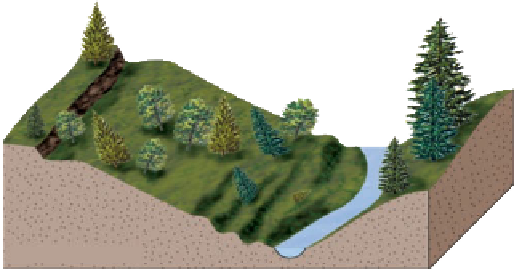Geology Reference
In-Depth Information
For this reason, clay beds are frequently the slippery layer
along which overlying rock units slide downslope.
◗
Figure 11.2
Undercutting a Slope's Base by Stream Erosion
Vegetation affects slope stability in several ways. By absorb-
ing the water from a rainstorm, vegetation decreases water
saturation of a slope's material that would otherwise lead to
a loss of shear strength. Vegetation's root system also helps
stabilize a slope by binding soil particles together and hold-
ing the soil to bedrock.
The removal of vegetation by either natural or human
activity is a major cause of many mass movements. Sum-
mer brush and forest fi res in southern California frequently
leave the hillsides bare of vegetation. Fall rainstorms satu-
rate the ground, causing mudslides that do tremendous
damage and cost millions of dollars to clean up. The soils
of many hillsides in New ealand are sliding because deep-
rooted native bushes have been replaced by shallow-rooted
grasses used for sheep grazing. When heavy rains saturate
the soil, the shallow-rooted grasses cannot hold the slope in
place, and parts of it slide downhill.
Undercutting by stream erosion removes a slope's base,
a
Original slope profile
Scarp
Overloading is almost always the result of
human activity and typically results from the
dumping, filling, or piling up of material.
Under natural conditions, a material's load is
carried by its grain-to-grain contacts, with the
friction between the grains maintaining a slope.
The additional weight created by overloading
increases the water pressure within the mate-
rial, which in turn decreases its shear strength,
thereby weakening the slope material. If enough
material is added, the slope will eventually fail,
sometimes with tragic consequences.
Surface of failure
which increases the slope angle, and can lead to slope failure.
b
Scarp
Scarp
The relationship between the topography
and the geology of an area is important in
determining slope stability (
Slump block
Slump block
Figure 11.5). If
the rocks underlying a slope dip in the same
direction as the slope, mass wasting is more
likely to occur than if the rocks are horizon-
tal or dip in the opposite direction. When the
rocks dip in the same direction as the slope,
water can percolate along the various bedding
planes and decrease the cohesiveness and
friction between adjacent rock units. This is
particularly true when clay layers are present
because clay becomes slippery when wet.
Even if the rocks are horizontal or dip in a direction
opposite to that of the slope, joints may dip in the same
direction as the slope. Water migrating through them weath-
ers the rock and expands these openings until the weight of
the overlying rock causes it to fall.
◗
Undercutting by stream erosion caused slumping along this stream near
Weidman, Michigan. Notice the scarp, which is the exposed surface of the
underlying material following slumping.
c
when wetted, they quickly lose cohesiveness and internal
friction and become an unstable slurry. This occurs because
clay, which can hold large quantities of water, consists of
platy particles that easily slide over each other when wet.




Search WWH ::

Custom Search